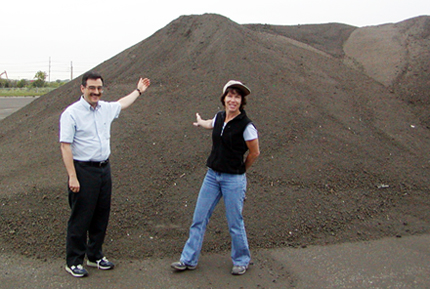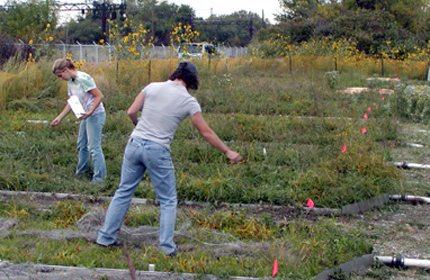5585 Guilford Road • Madison, WI 53711-5801 • 608-273-8080 • Fax 608-273-2021
www.agronomy.org
Twitter | Facebook
NEWS RELEASE
Contact: Hanna Jeske, Associate Director of Marketing and Brand Strategy, 608-268-3972, hjeske@sciencesocieties.org
Flushed resource restores ecosystem
Every city has abandoned industrial sites. Encouraging life to return to these barren areas is a challenge. It requires a healthy topsoil for plants and animals to flourish. Cities, with their heavily compacted and often contaminated soils, often struggle to restore blighted spaces. Quality soil is necessary—but not abundant in cities. Enter biosolids.
 The Lake Calumet Cluster Site (LCCS) was the home of five U.S steel plants on the southeast side of Chicago. Now it’s an 87-acre wasteland of glassy slag—a rocky byproduct of steel manufacturing.
The Lake Calumet Cluster Site (LCCS) was the home of five U.S steel plants on the southeast side of Chicago. Now it’s an 87-acre wasteland of glassy slag—a rocky byproduct of steel manufacturing.
“It’s a mess,” says Nick Basta, “Sixty percent of the land is bare rock.”
The site used to be a wetland, but years of infill, dumping, and excavation has rendered the area inhospitable to plants and animals. It is on the EPA’s national priority list. Over the last few years, the city has tried to restore the area. The hope is that it will become a stop for migratory birds along Lake Michigan’s shoreline.
Restoration efforts of this scale are difficult. The original plan put forth by the restoration team was a two-inch layer of compost on the site. To Basta, this wasn’t the answer.
“I love compost, but it’s just not good enough,” he said. A good soil provides the right combination of depth, nutrients, and texture to support bacteria, fungus, insects, and worms. Compost lacks essential plant nutrients, and is easily dispersed by rain and wind. A soil teeming with microscopic life is ideal for restoring plant and animal communities.
Basta and his team from the School of Environment and Natural Resources at Ohio State University, along with Lakhwinder Hundal and Kuldip Kumar from the Chicago Metropolitan Water Reclamation District (MWRD), decided to manufacture their own soil with help from the nearby wastewater treatment plant.
 Chicago’s MWRD makes creative use of the enormous amount of waste Chicago generates. One example is biosolids—a rebirthing of sewage into a clean, pathogen-free, nutrient-dense growing material. Two years of physical, chemical, and biological treatment turns what was once sludge into a rich growing medium. These biosolids have a wealth of organic matter and are full of plant nutrients. It’s an ideal base for diversity. In July 2015, Illinois legislation declared biosolids an approved resource for healthy lawns and growing crops.
Chicago’s MWRD makes creative use of the enormous amount of waste Chicago generates. One example is biosolids—a rebirthing of sewage into a clean, pathogen-free, nutrient-dense growing material. Two years of physical, chemical, and biological treatment turns what was once sludge into a rich growing medium. These biosolids have a wealth of organic matter and are full of plant nutrients. It’s an ideal base for diversity. In July 2015, Illinois legislation declared biosolids an approved resource for healthy lawns and growing crops.
Basta and his team collaborated with MWRD to create a soil blend using biosolids. “We called it the dream treatment,” said Basta. They tilled it into test plots just outside the LCCS site. Researchers created a second plot with compost—a thick, organic-rich material degraded from hardwood trees. The team scattered native plant seeds on both plots.
The biosolids plots proved to be the best home for healthy bacteria, fungus and plants—important indicators for a thriving ecosystem. Worms were happy in both the compost and biosolids plots.
“The next step is blending the biosolids and the compost,” said Basta.
The city of Chicago already uses biosolids for golf courses and baseball diamonds. Basta hopes that biosolids can restore the degraded surface area of LCCS, and the poor quality soils typical in Chicago’s dense urban areas.
“You have to bring in the soil,” said Basta “Why not connect the dots and bring in what’s available locally?”
Read more about the “dream treatment” in a special section of the Journal of Environmental Quality, “Soil in the City.”
Journal of Environmental Quality publishes original research, reviews and analyses, and environmental issue articles that address anthropogenic impacts on water, soil, and the atmosphere and pertain to some aspect of environmental quality in natural and agricultural ecosystems.